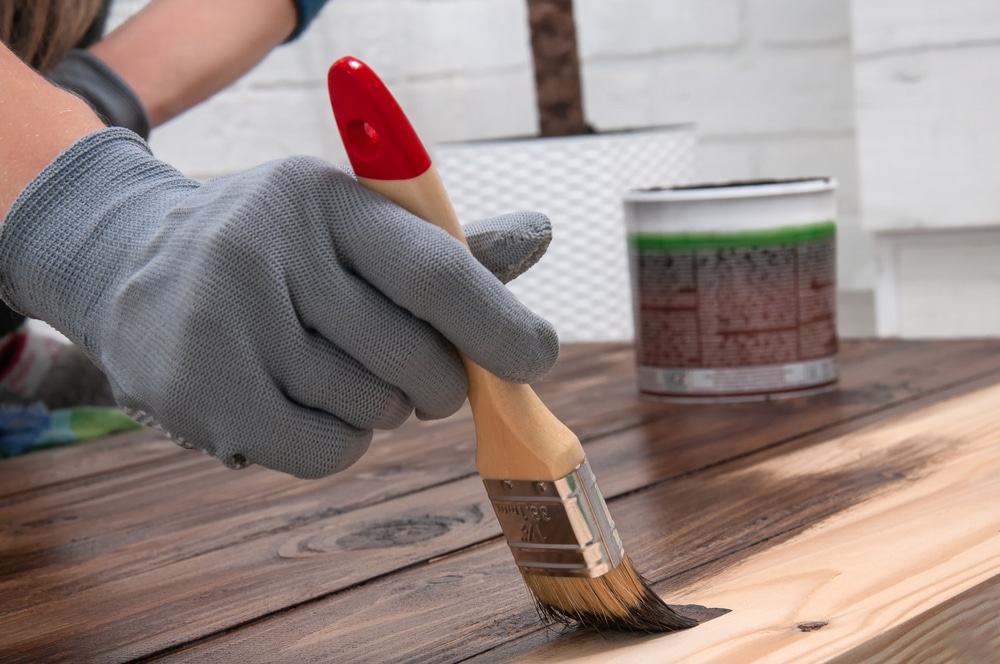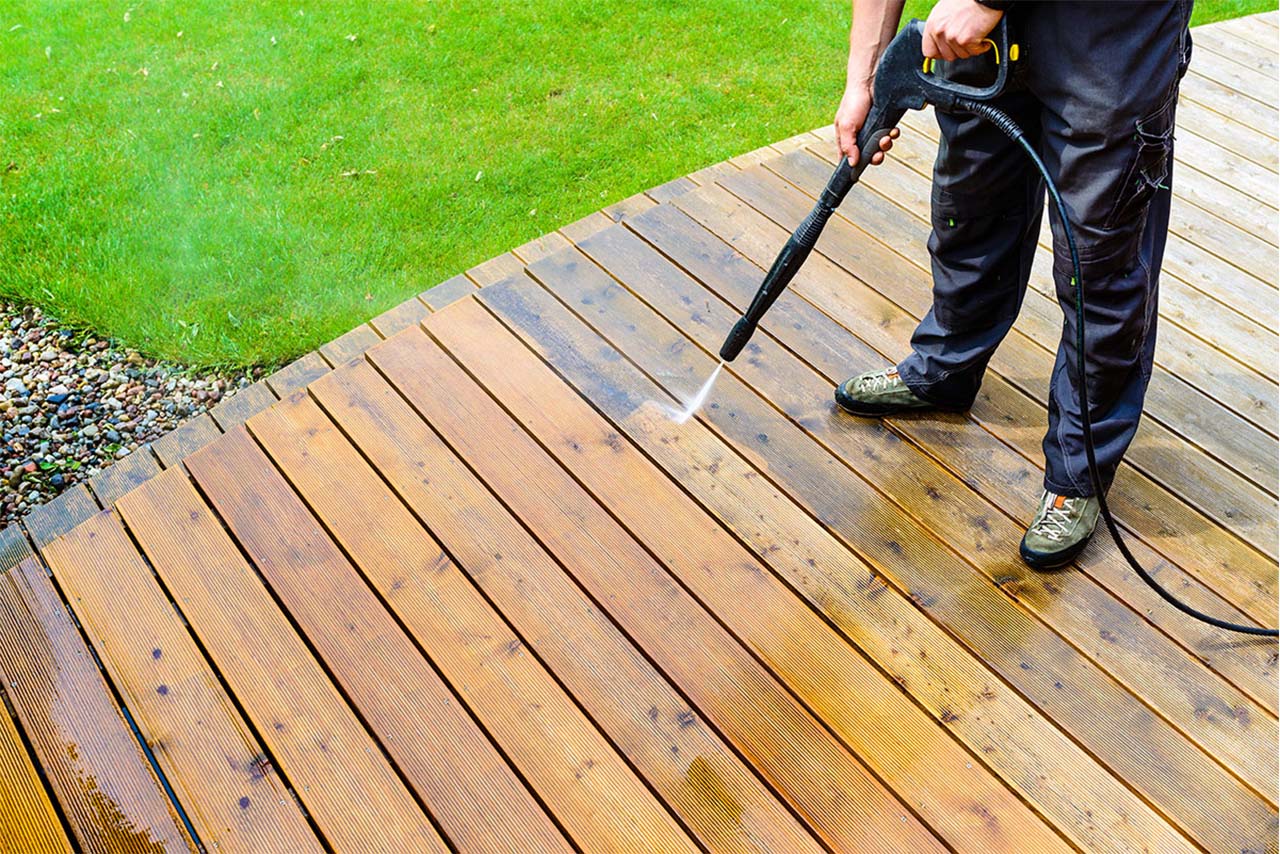There are a few different ways you can treat your hardwood decking to preserve it and accentuate its natural beauty. Many people go with decking stains to customize the look of their deck, while others prefer an oiled approach to enhance the wood’s natural textures. There are no right or wrong approaches here; it really boils down to your personal preference.
That said, there are some things you should consider before setting out on your decking treatment journey, since each treatment offers different outcomes. However, regardless of the treatment you choose, the first thing to do is properly clean and prepare your deck.
Cleaning and Preparing Your Deck for Treatment
Effectively cleaning your deck is crucial to the treatment processes. Treating your wood without cleaning it can seal in unsightly blemishes that are next to impossible to remove later, so it’s important to be thorough in your cleaning process.
A pressure washer is, by far, the fastest and most effective approach for cleaning your deck. Simply hook it up and start blasting — you can even leave your deck furniture in place and give it a good cleaning, too.
For those without access to a power washer, a stiff brush, a bucket of soapy water and some good old-fashioned elbow grease work just as well. There are also dedicated cleaning products you can pick up to speed the process along. These solutions are handy for ongoing cleaning or winter maintenance, too, since they often have chemicals that kill mold and prevent it from growing.
Whatever approach you use for cleaning, just remember to be thorough. Take your time with the process and check every corner before moving on to any treatments. As the old saying goes, “Measure twice, cut once.”
Treating Your Wood Deck With Oil
Now that your deck is cleaned and ready for treatment, it’s time to pick your approach. When you visit your local hardware store, all the decking oils you’ll find are derivatives of the following:
- Linseed oil
- Danish oil
- Varnish
- All-in-one products
You can use any one of these products to treat your entire deck, though it’s worth noting that oil-based treatments require regular applications two to three times per year. Decking stain treatments last longer but may not be what you’re looking for in terms of function and appearance. We’ll get into that a little further on.
Treating Timber Decking with Linseed Oil
Linseed decking oil derivatives are extremely versatile deck treatments. In particular, they’re great for treating hardwoods. They’re made from the extract of flaxseed and may also be labeled as flaxseed oil. In addition to being used for the treatment of various types of wood materials, linseed oil is also a dietary supplement, making it an extremely safe option for people with pets. It also has an odor many people find pleasing.
When used to treat a deck, linseed decking oil accentuates the natural grain of the wood and allows it to weather over time, giving your deck a warm, organic appearance that’s impossible with other finishes. The downside is that it doesn’t provide the same level of protection that varnish does. It won’t prevent scratching, and it also allows water to penetrate, so you have to be mindful of mold and mildew.
One of the biggest issues with linseed oil is that it can take a very long time to dry during application. To help alleviate this, manufacturers have produced what’s called boiled linseed oil. While not actually boiled, this product has additives such as mineral spirits and turpentine to help it dry more quickly.
To apply linseed oil, use a rag or a brush and rub the oil into all the exposed wood on your deck. Be liberal with the oil, but don’t allow it to pool in areas. The wood will naturally be “thirstier” in certain areas and absorb more oil. Simply apply more oil where it’s needed.
Allow your deck boards to soak in the oil for about an hour and then rub them down with a dry cloth to spread any pooled oil. This will provide your deck with a much more even finish once you’re done. It’s also worth noting that how much oil you need will depend on a variety of factors, including how dry your wood decking is and the temperature and humidity of the environment.
After the initial treatment, you’ll want to give the wood at least 24 hours to fully absorb the oil. Be sure to follow the guidelines provided by your specific product. If you need to apply a second coat, you can follow the same process as before, though with thinner layers of oil.

Treating Wood Decking with Danish Oil
Danish oil is a product made from various kinds of oils mixed with varnish. The oils are usually either tung or linseed but can include poppy, cotton or sunflower oils, too. The mixture is typically around half oil and half varnish.
The purpose of Danish oil is to provide the natural aesthetics of oils without the downsides. The added varnish helps protect your wood while still allowing it to breathe. It’s also fairly easy to apply and dries quickly without strong odors. Danish oil also provides some UV protection and protection from wood-boring insects. That said, it’s slipperier than a pure oil treatment, so this is something you’ll want to consider.
Danish oil is best applied with a rag. Given the varnish content, it’s a good idea to use disposable gloves during application. Also, be sure to dispose of the rag when you’re finished treating your deck. As with pure oil treatments, the amount needed will vary depending on your wood and the temperature and humidity. Drying times will typically be quicker, though you’ll still want to allow your deck to fully absorb each coat between applications.
Varnish and All-in-One Treatments
Pure varnish treatments generally aren’t recommended for timber decking. While varnish certainly provides great protection, it also creates an extremely glossy finish that can be dangerous and slippery to walk on.
There are all-in-one treatments that combine the protective qualities of varnish, the natural look of an oil and the rich colors of deck stain. They can provide the same level of protection and finish with a single application, though they’re limited in terms of colors and appearance. This can be a good approach for treating a new deck but might be less preferable for touching up or maintaining older decks.
Conclusion
There’s a range of products you can choose from to treat your wood deck, but there are no hard rules for which one you should use. At the end of the day, it comes down to personal preference. Knowing what each treatment provides in terms of aesthetics and protection will help you choose. If you’re still uncertain, test each one out on some wood cut-offs and see which one suits you best.


